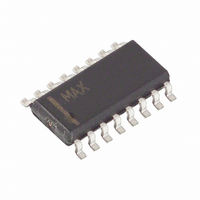DS3992Z-18N+T&R Maxim Integrated Products, DS3992Z-18N+T&R Datasheet - Page 8

DS3992Z-18N+T&R
Manufacturer Part Number
DS3992Z-18N+T&R
Description
IC CCFL CNTRLR 2CH 16-SOIC
Manufacturer
Maxim Integrated Products
Type
CCFL Controllerr
Datasheet
1.DS3992Z-18P.pdf
(13 pages)
Specifications of DS3992Z-18N+T&R
Frequency
40 ~ 80 kHz
Current - Supply
8mA
Voltage - Supply
4.5 V ~ 5.5 V
Operating Temperature
-40°C ~ 85°C
Package / Case
16-SOIC (3.9mm Width)
Lead Free Status / RoHS Status
Lead free / RoHS Compliant
Current - Output
-
Lead Free Status / Rohs Status
Details
during this time. During the low period of the DPWM
cycle, the controller disables the MOSFET gate drivers
so the lamp is not driven. This causes the current to
stop flowing in the lamp, but the time is short enough to
keep the lamp from de-ionizing. Dimming is increased/
decreased by adjusting (i.e., modulating) the burst
period duty cycle. At the beginning of each burst dim-
ming cycle, there is a soft-start whereby the lamp cur-
rent is slowly ramped to reduce the potential to create
audible transformer noise.
The slope of the BRIGHT dimming input is either posi-
tive or negative as shown in Table 1. For voltages
between 0.5V and 2.0V, the duty cycle will vary linearly
between the minimum and 100%.
On lamp strike, the DS3992 boosts the normal operat-
ing lamp frequency by 33%. This is done to increase
the voltage created and help insure that the lamp
strikes. In addition, the maximum strike voltage will be
applied to the lamp for over 500ms. Once the controller
detects that the lamp has struck, the frequency is
returned to the normal lamp frequency.
Both the lamp and DPWM frequencies are set using
external resistors. The resistance required for either fre-
quency can be determined using the following formula:
where K = 1600kΩ x kHz for lamp frequency calcula-
tions. When calculating the resistor value for the DPWM
frequency, K will be one of two values depending on
the DS3992 version. If using the -09N/P version (90Hz
to 220Hz) then K = 4kΩ x kHz. K = 8kΩ x kHz for the
-18N/P version (180Hz to 440Hz).
Example: Selecting the resistor values to configure the
-09P version to have a 50kHz lamp frequency and a
160Hz DPWM frequency: For the DPWM resistor calcula-
tion, K = 4kΩ x kHz. For the lamp-frequency-resistor
(R
the lamp frequency K value regardless of the frequency.
Two-Channel, Push-Pull CCFL Controller
Table 1. BRIGHT Analog Dimming Input Configuration
8
DS3992Z-09P and DS3992Z-18P
DS3992Z-09N and DS3992Z-18N
LOSC
_____________________________________________________________________
) calculation, K = 1600kΩ x kHz, which is always
Setting the Lamp and DPWM Frequencies
DEVICE
R
OSC
=
f
OSC
Using External Resistors
K
Negative
Positive
SLOPE
Lamp Strike
MINIMUM BRIGHTNESS
The previous formula can now be used to calculate the
resistor values for R
The DS3992 has supply voltage monitors for both the
inverter’s DC supply (V
ensure that both voltage levels are adequate for proper
operation. The inverter supply is monitored for under-
voltage conditions at the SVM pin. An external resistor-
divider at the SVM input feeds into a comparator (see
Figure 1) having a 2V threshold. Using the equation
below to determine the resistor values, the inverter sup-
ply trip point (V
inverter when the inverter supply voltage drops below
the specified value.
Operating with the inverter voltage at too high of a level
can be damaging to the inverter components. Proper
use of the SVM can prevent this problem. If desired, SVM
can be disabled by connecting the SVM pin to GND.
The V
(UVLO) that prevents operation when the DS3992 does
not have adequate voltage for its analog circuitry to
operate or to drive the external MOSFETs. The V
monitor features hysteresis to prevent V
causing spurious operation when V
point. This monitor cannot be disabled by any means.
The DS3992 provides extensive fault monitoring for
each channel. It can detect open-lamp, lamp overcur-
rent, failure to strike, and overvoltage conditions. Figure
4 shows a flowchart of how the DS3992 controls and
monitors each channel. The steps are as follows:
The lamps will not turn on unless the DS3992 supply
voltage is > 4.5V and the voltage at the supply voltage
monitor (SVM) input is > 2V.
BRIGHT < 0.5V
BRIGHT > 2.0V
CC
monitor is a 5V supply undervoltage lockout
R
LOSC
R
POSC
TRIP
V
=
TRIP
LOSC
) can be customized to shut off the
=
1600
4
INV
0 160
=
k
and R
.
Ω
50
k
) and its own V
2 0
Ω
.
kHz
MAXIMUM BRIGHTNESS
x kHz
kHz
x kHz
⎛
⎜
⎝
POSC
R
Supply Monitoring
BRIGHT > 2.0V
BRIGHT < 0.5V
1
Fault Monitoring
R
+
1
=
CC
as follows:
R
=
25
2
is near the trip
⎞
⎟
⎠
32
CC
k
Ω
CC
k
Ω
noise from
supply to
CC













